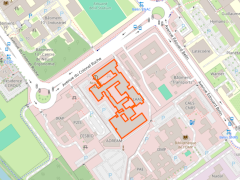Aerial Robotics
Our objective is to design, model, and control drones that can physically interact with the environment and, in particular, with humans.
Human-drone interaction
Aerial robots (a.k.a. drones) have been proven to be excellent in performing several tasks -- spanning from navigation to surveillance -- mostly thanks to their agility and ability to move quickly. However, these robots have been mostly used as "flying sensors'', without considering any physical interaction with the environment, which would significantly extend their range of applications.
In this research direction, our objective is to design, model, and control novel aerial manipulators (drones equipped with robotic arms) that can physically interact with the environment and, in particular, with humans. Regarding the latter, we are interested in
- Human modeling: Derive novel mathematical models that describe the behavior of a human while interacting with a drone.
- Control/shared autonomy: Design robust controllers (e.g., robust MPC or based on shared autonomy) to generate a safe human-robot interaction.
- Designing novel aerial manipulators - drones with robotic arms specifically designed for interacting with the environment including humans.
Examples of open questions are
- Which mathematical model(s) of the human can be employed in human-drone interaction?
- How to estimate/retrieve this human-related information?
- How to exploit this information/models for controlling the robot?
Other research directions
- Heterogeneous systems: Each category of robots, including drones, ground robots, and manipulators, offers distinct advantages and faces specific challenges. The idea of this research line is to fuse the different strengths of different kinds of robots to fulfill tasks that homogeneous teams cannot.
- Active perception: The aim of this research is to determine the robot's actions that minimize the estimation uncertainty that affects the robot sensors and actuators, in order to optimize the robot localization [2].
References
[1] M. Selvaggio et al., "Autonomy in Physical Human-Robot Interaction: A Brief Survey," in IEEE Robotics and Automation Letters, vol. 6, no. 4, pp. 7989-7996, Oct. 2021, doi: 10.1109/LRA.2021.3100603. Link
[2] M. Cognetti et al., "Optimal Active Sensing with Process and Measurement Noise," 2018 IEEE International Conference on Robotics and Automation (ICRA), Brisbane, QLD, Australia, 2018, pp. 2118-2125, doi: 10.1109/ICRA.2018.8460476. Link












